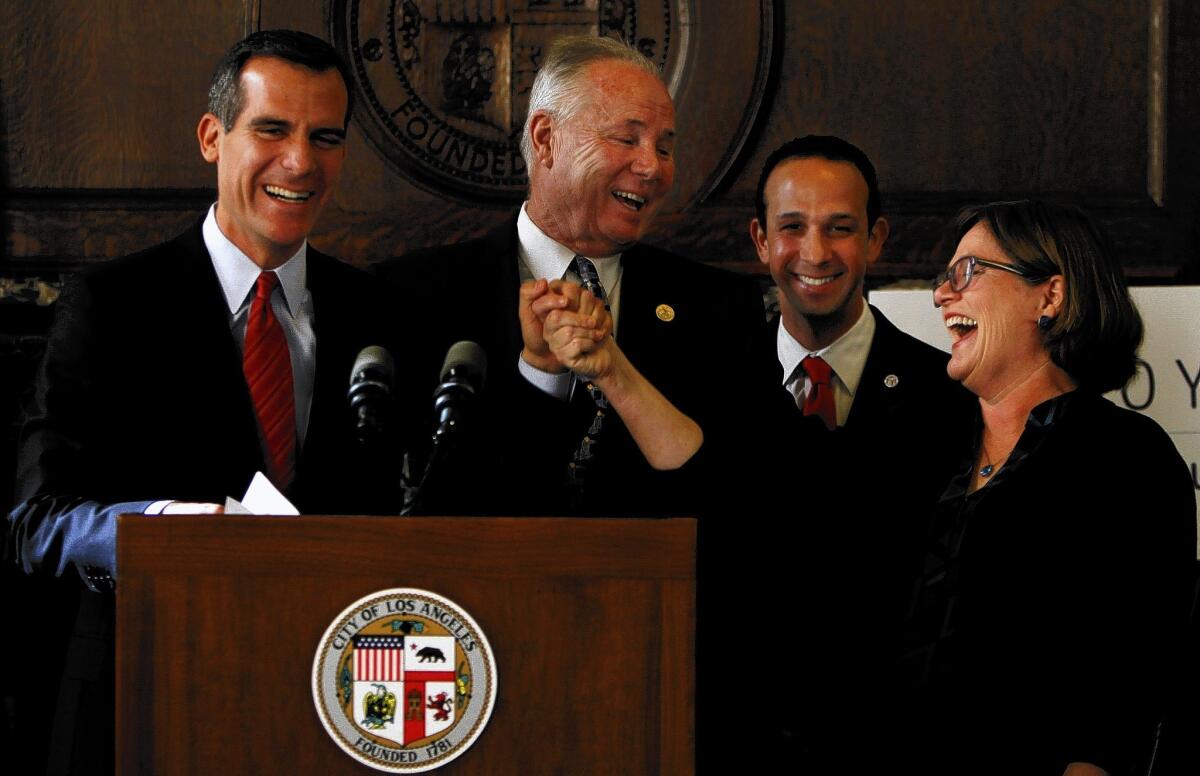L.A. Mayor Garcetti to push for greater earthquake safety

Los Angeles Mayor Eric Garcetti on Tuesday announced an ambitious plan to tackle earthquake safety, including a new effort to strengthen vulnerable buildings.
Marking the 20th anniversary of the destructive Northridge earthquake, Garcetti said Los Angeles would for the first time partner with the U.S. Geological Survey to better protect private buildings as well as telecommunications and water supplies during a major temblor.
The move comes as the City Council is considering several seismic safety initiatives, including creating inventories of potentially dangerous concrete and wooden apartment buildings. The identification of these buildings is considered a crucial first step in any effort to strengthen them.
Taken together, they mark the most significant effort to improve earthquake safety in Los Angeles in a generation.
“What’s really at stake is the viability of this city,” said prominent USGS seismologist Lucy Jones, who will spend a year working on the effort.
The dangers of concrete and wooden apartment buildings with weak first stories have been known for decades, a threat underscored when the 6.7 Northridge earthquake rumbled through Los Angeles on Jan. 17, 1994. About 60 people died and more than 40,000 buildings were damaged across Southern California.
But political opposition and a lack of interest at the City Council in the 1990s thwarted efforts to require older buildings to be strengthened against future earthquakes.
The mayor vowed that this time would be different.
“I think there’s a tremendous momentum,” Garcetti told reporters Tuesday. He said there was now a “feeling of urgency.”
The USGS will lend out Jones as the mayor’s science advisor this year. It is an unusual partnership, but one with which the federal government agreed is consistent with her day job: finding ways to reduce the nation’s earthquake risk.
“Los Angeles County has one-quarter of the nation’s seismic risk in our county alone, when you put 10 million people on top of 100 faults,” Jones said. “If we can come up with a solution here … it’d make a big difference.”
A city has never asked the USGS for this kind of help, she said.
“I hope this becomes a prototype for ways in which we take our science and get it applied and actually make a difference,” Jones said.
Finding a solution that can win political support will be a big challenge. Mandatory retrofits can impose significant financial burdens on property owners, and only a few cities have passed such laws. In Los Angeles, those costs have killed past efforts to require owners to pay for safety upgrades.
Wayne Spindler, an Encino homeowner who owns several other properties, was dismayed at the prospect of more regulation.
“By identifying buildings as potential earthquake hazards, you’re depressing the prices and resale values of these properties. So this is a continued attack on the middle class and the renters,” Spindler told the City Council.
Councilman Tom LaBonge later offered a response to owners upset by the cost: “Before they cringe, I just want to say, I want to have them be alive.”
The mayor laid out the year’s goals: First, identify the problems, then this spring talk to property owners and tenants, and consult with technical experts about solutions.
“This comes at a cost. This is a politically difficult thing to do. But we’re committed to making sure that we hold public meetings across Los Angeles to let people know” about the risk, Garcetti said.
By summer, Jones will begin developing recommendations, with final reports to Garcetti by the end of the year.
Garcetti said he was particularly interested in the concerns of property owners “as we discuss how to retrofit privately owned buildings.”
Meanwhile, the City Council is considering a number of measures to improve seismic safety, including creating inventories of buildings possibly vulnerable to collapse in an earthquake.
The motions, introduced by LaBonge and Councilmen Mitch Englander and Bernard C. Parks, followed Times reports on concrete and wooden apartment buildings last year.
In October, The Times reported that by the most conservative estimate, as many as 50 of the more than 1,000 older concrete buildings in the city — those built before 1976 — would collapse in a major earthquake, exposing thousands to injury or death.
Although concrete buildings look strong, many older ones are vulnerable to the sideways movement of a major earthquake because they don’t have enough steel reinforcement to hold columns in place. Experts say sorting out which present the greatest danger will require building-by-building assessments by structural engineers.
Several concrete structures collapsed catastrophically in the Northridge earthquake, which hit at 4:31 a.m., including a Kaiser Permanente medical office and a Bullock’s department store. The death toll could have been in the hundreds had the earthquake occurred during working hours. During the 1971 Sylmar quake, three concrete medical buildings collapsed, killing about 50 people.
Wooden apartment buildings with weak ground floors, known as “soft-story” structures, often are built over carports and held up with slender columns. The Northridge earthquake damaged or destroyed about 200 of these structures, and 16 people died in the Northridge Meadows apartment complex when the upper floors collapsed onto the first floor.
Despite the destruction from the 1994 earthquake, City Hall has paid little attention to how to help owners fund retrofits, Englander said.
This time is different, he said.
Englander said he’s working with a lawmaker to introduce a bill in Sacramento that would give owners a tax incentive for seismic retrofits. There has been also talk of a state bond measure that would provide funding to cities for retrofitting and other seismic work.
Los Angeles has lagged behind other cities in earthquake safety regulations.
San Francisco officials passed a law requiring thousands of owners to retrofit wooden soft-story apartments and hired an “earthquake czar” to manage a 30-year plan to strengthen other vulnerable buildings. Berkeley and Fremont have also ordered soft-story retrofits.
“Earthquake preparedness is kind of like a balloon. If you don’t continually put air into it, it will deflate,” Garcetti said. “Too many in our city have stopped thinking about how we can best prepare.”
More to Read
Sign up for Essential California
The most important California stories and recommendations in your inbox every morning.
You may occasionally receive promotional content from the Los Angeles Times.













